Search results for 'SELECT * FROM MM_MOVIE;'
-
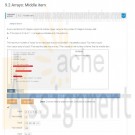
PRG 211 Week 4 Labs
Regular Price: $12.00
Special Price $9.00
PRG 211 Week 4 Labs
Lab 9.1 Output numbers in reverse
Write a program that reads a list of 10 integers, and outputs those integers in reverse. For coding simplicity, follow each output integer by a space, including the last one. Then, output a newline.
Ex: If the input is 2 4 6 8 10 12 14 16 18 20, the output is:
20 18 16 14 12 10 8 6 4 2
To achieve the above, first read the integers into an array. Then output the array in reverse.
Lab 9.2 Middle itemGiven a sorted list of integers, output the middle integer. Assume the number of integers is always odd.
Ex: If the input is 2 3 4 8 11 -1 (a negative indicates end), the output is:
4
The maximum number of inputs for any test case should not exceed 9. If exceeded, output "Too many inputs".Hint: Use an array of size 9. First read the data into an array. Then, based on the number of items, find the middle item.
Lab 9.3 Output values below an amountWrite a program that first gets a list of 5 integers from input. Then, get another value from the input, and output all integers less than or equal to that value.
Ex: If the input is 50 60 140 200 75 100, the output is:
50 60 75
For coding simplicity, follow every output value by a space, including the last one. Then, output a newline.Such functionality is common on sites like Amazon, where a user can filter results.
Learn More -

PRG 211 Week 3 Labs
Regular Price: $15.00
Special Price $12.00
PRG 211 Week 3 Labs
Lab 7.1 Loops Convert to binary
Write a program that takes in a positive integer as input, and outputs a string of 1's and 0's representing the integer in binary. For an integer x, the algorithm is:
As long as x is greater than 0
Output x % 2 (remainder is either 0 or 1)
x = x / 2
Note: The above algorithm outputs the 0's and 1's in reverse order.Ex: If the input is 6, the output is:
011
(6 in binary is 110; the algorithm outputs the bits in reverse).
Lab 7.2 Loops Varied amount of input dataStatistics are often calculated with varying amounts of input data. Write a program that takes any number of non-negative integers as input, and outputs the average and max. A negative integer ends the input and is not included in the statistics.
Ex: When the input is 15 20 0 5 -1, the output is:
10 20
You can assume that at least one non-negative integer is input.
Lab 7.3 Loops Output range with increment of 10Write a program whose input is two integers, and whose output is the first integer and subsequent increments of 10 as long as the value is less than or equal to the second integer.
Ex: If the input is -15 30, the output is:
-15 -5 5 15 25Ex: If the second integer is less than the first as in 20 5, the output is:
Second integer can't be less than the first.For coding simplicity, output a space after every integer, including the last.
Lab 7.4 Loops Countdown until matching digitsWrite a program that takes in an integer in the range 20-98 as input. The output is a countdown starting from the integer, and stopping when both output digits are identical.
Ex: If the input is 93, the output is:
93 92 91 90 89 88Ex: If the input is 77, the output is:
77Ex: If the input is not between 20 and 98 (inclusive), the output is:
Input must be 20-98For coding simplicity, follow each output number by a space, even the last one. Use a while loop. Compare the digits; do not write a large if-else for all possible same-digit numbers (11, 22, 33, ..., 88), as that approach would be cumbersome for large ranges.
Learn More -
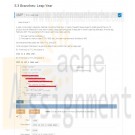
PRG 211 Week 2 Labs
Regular Price: $12.00
Special Price $9.00
Lab 5.1 Largest number
Write a program whose inputs are three integers, and whose output is the largest of the three values.
Ex: If the input is 7 15 3, the output is:
15
Lab 5.2 Remove gray from RGBSummary: Given integer values for red, green, and blue, subtract the gray from each value.
Computers represent color by combining the sub-colors red, green, and blue (rgb). Each sub-color's value can range from 0 to 255. Thus (255, 0, 0) is bright red, (130, 0, 130) is a medium purple, (0, 0, 0) is black, (255, 255, 255) is white, and (40, 40, 40) is a dark gray. (130, 50, 130) is a faded purple, due to the (50, 50, 50) gray part. (In other words, equal amounts of red, green, blue yield gray).
Given values for red, green, and blue, remove the gray part.
Ex: If the input is 130 50 130, the output is:
80 0 80
Find the smallest value, and then subtract it from all three values, thus removing the gray.Note: This page converts rgb values into colors.
Lab 5.3 Leap YearA year in the modern Gregorian Calendar consists of 365 days. In reality, the earth takes longer to rotate around the sun. To account for the difference in time, every 4 years, a leap year takes place. A leap year is when a year has 366 days: An extra day, February 29th. The requirements for a given year to be a leap year are:
1. The year must be divisible by 4
2. If the year is a century year (1700, 1800, etc.), the year must be evenly divisible by 400
Some example leap years are 1600, 1712, and 2016.Write a program that takes in a year and determines whether that year is a leap year.
Ex: If the input is 1712, the output is:
1712 is a leap year.Ex: If the input is 1913, the output is:
Learn More
1913 is not a leap year. -
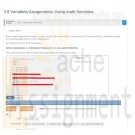
PRG 211 Week 1 Labs
Regular Price: $15.00
Special Price $12.00
Lab 3.1 Formatted Output Hello World!
Write a program the outputs 'Hello World!'
Lab 3.2 Formatted output: No parking sign.Write a program that prints a formatted "No parking" sign. Note the first line has two leading spaces.
NO PARKING
1:00 - 5:00 a.m.
Lab 3.3 House real estate summarySites like Zillow get input about house prices from a database and provide nice summaries for readers. Write a program with two inputs, current price and last month's price (both integers). Then, output a summary listing the price, the change since last month, and the estimated monthly mortgage computed as (currentPrice * 0.045) / 12.
Ex: If the input is 200000 210000, the output is:
This house is $200000. The change is $-10000 since last month.
The estimated monthly mortgage is $750.0.
Note: Getting the precise spacing, punctuation, and newlines exactly right is a key point of this assignment. Such precision is an important part of programming.
Lab 3.4 Caffeine levelsA half-life is the amount of time it takes for a substance or entity to fall to half its original value. Caffeine has a half-life of about 6 hours in humans. Given caffeine amount (in mg) as input, output the caffeine level after 6, 12, and 18 hours.
Ex: If the input is 100, the output is:
After 6 hours: 50.0 mg
After 12 hours: 25.0 mg
After 18 hours: 12.5 mg
Note: A cup of coffee has about 100 mg. A soda has about 40 mg. An "energy" drink (a misnomer) has between 100 mg and 200 mg.
Lab 3.5 Divide by x.Write a program using integers userNum and x as input, and output userNum divided by x four times.
Ex: If the input is 2000 2, the output is:
1000 500 250 125
Note: In Coral, integer division discards fractions. Ex: 6 / 4 is 1 (the 0.5 is discarded).
Lab 3.6 Driving costs.Driving is expensive. Write a program with a car's miles/gallon and gas dollars/gallon (both floats) as input, and output the gas cost for 10 miles, 50 miles, and 400 miles.
Ex: If the input is 20.0 3.1599, the output is:
1.57995 7.89975 63.198
Note: Small expression differences can yield small floating-point output differences due to computer rounding. Ex: (a + b)/3.0 is the same as a/3.0 + b/3.0 but output may differ slightly. Because our system tests programs by comparing output, please obey the following when writing your expression for this problem. First use the dollars/gallon and miles/gallon values to calculate the dollars/mile. Then use the dollars/mile value to determine the cost per 10, 50, and 400 miles.Note: Real per-mile cost would also include maintenance and depreciation.
Lab 3.7 Simple statistics.Part 1
Given 3 integers, output their average and their product, using integer arithmetic.Ex: If the input is 10 20 5, the output is:
11 1000
Note: Integer division discards the fraction. Hence the average of 10 20 5 is output as 11, not 11.666666666666666.Submit the above for grading. Your program will fail the test cases (which is expected), until you complete part 2 below but check that you are getting the correct average and product using integer division.
Part 2
Also output the average and product, using floating-point arithmetic.Ex: If the input is 10 20 5, the output is:
11 1000
11.666666666666666 1000.0
Lab 3.8 Using math functionsGiven three floating-point numbers x, y, and z, output x to the power of y, x to the power of (y to the power of z), the absolute value of x, and the square root of (xy to the power of z).
Ex: If the input is 5.0 6.5 3.2, the output is:
34938.56214843421 1.2995143401732918e+279 5.0 262.42993783925596
Hint: Coral has built-in math functions (discussed elsewhere) that may be used.
Learn More
Function Behavior Example
SquareRoot(x) Square root of x SquareRoot(9.0) evaluates to 3.0.
RaiseToPower(x, y) Raise x to power y: RaiseToPower(6.0, 2.0) evaluates to 36.0.
AbsoluteValue(x) Absolute value of x AbsoluteValue(-99.5) evaluates to 99.5. -
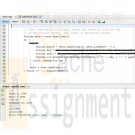
PRG/421 Week 2 Java Lab 2.22 LAB: Parsing dates
Regular Price: $6.00
Special Price $3.00
PRG/421 Week 2 Java Lab 2.22 LAB: Parsing dates
Complete main() to read dates from input, one date per line. Each date's format must be as follows: March 1, 1990. Any date not following that format is incorrect and should be ignored. Use the substring() method to parse the string and extract the date. The input ends with -1 on a line alone. Output each correct date as: 3/1/1990.
Ex: If the input is:
March 1, 1990
April 2 1995
7/15/20
December 13, 2003
-1then the output is:
Learn More
3/1/1990
12/13/2003 -
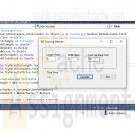
Programming with Microsoft VB 2017 Diane Zak Chapter 10 Fence Solution
Regular Price: $7.00
Special Price $5.00
Programming with Microsoft VB 2017 Diane Zak Chapter 10 Fence Solution
In this exercise, you create an application that can be used to calculate the cost of installing a fence around a rectangular area. Create a Windows Forms application. Use the following names for the project and solution, respectively: Fence Project and Fence Solution. Save the application in the VB2017\Chap10 folder:
a. Use Windows to copy the Rectangular.vb file from the VB2017\Chap10 folder to the Fence Project folder. Then, use the Project menu to add the file to the project.
b. Modify the Rectangular class to use the Double (rather than Integer) variables.
c. Add a method named GetPerimeter to the Rectangle class. The method should calculate and return the perimeter of a rectangle. To calculate the perimeter, the method will need to add together the length and width measurements and then multiply the sum by 2.
d. Create the interface shown in Figure 10-41 and then code the application. Save the solution and then start and test the application.
Learn More -
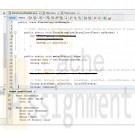
PRG/421 Week 3 Java 3.21 LAB: Plant information (ArrayList)
Regular Price: $6.00
Special Price $3.00
PRG/421 Week 3 Java 3.21 LAB: Plant information (ArrayList)
Given a base Plant class and a derived Flower class, complete main() to create an ArrayList called myGarden. The ArrayList should be able to store objects that belong to the Plant class or the Flower class. Create a method called printArrayList(), that uses the printInfo() methods defined in the respective classes and prints each element in myGarden. The program should read plants or flowers from input (ending with -1), adding each Plant or Flower to the myGarden ArrayList, and output each element in myGarden using the printInfo() method.
Ex. If the input is:
plant Spirea 10
flower Hydrangea 30 false lilac
flower Rose 6 false white
plant Mint 4
-1the output is:
Learn More
Plant Information:
Plant name: Spirea
Cost: 10
Plant Information:
Plant name: Hydrengea
Cost: 30
Annual: false
Color of flowers: lilac
Plant Information:
Plant name: Rose
Cost: 6
Annual: false
Color of flowers: white
Plant Information:
Plant name: Mint
Cost: 4 -
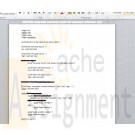
IT 140 Higher/Lower Game Pseudocode Project One
Regular Price: $8.00
Special Price $5.00
IT 140 Higher/Lower Game Pseudocode Project One
Higher/Lower Game Description
Your friend Maria has come to you and said that she has been playing the higher/lower game with her three-year-old daughter Bella. Maria tells Bella that she is thinking of a number between 1 and 10, and then Bella tries to guess the number. When Bella guesses a number, Maria tells her whether the number she is thinking of is higher or lower or if Bella guessed it. The game continues until Bella guesses the right number. As much as Maria likes playing the game with Bella, Bella is very excited to play the game all the time. Maria thought it would be great if you could create a program that allows Bella to play the game as much as she wants.For this assignment, you will be designing pseudocode for a higher/lower game program. The higher/lower game program uses similar constructs to the game you will design and develop in Projects one and Two.
1) Review the Higher/Lower Game Sample Output for more detailed examples of this game. As you read, consider the following questions:
What are the different steps needed in this program? How can you break them down in a way that a computer can understand?
What information would you need from the user at each point (inputs)? What information would you output to the user at each point?
When might it be a good idea to use "IF" and "IF ELSE" statements?
When might it be a good idea to use loops?2) Create a pseudocode that logically outlines each step of the game program so that it meets the following functionality:
Prompts the user to input the lower bound and upper bound. Include input validation to ensure that the lower bound is less than the upper bound.
Generates a random number between the lower and upper bounds
Prompts the user to input a guess between the lower and upper bounds. Include input validation to ensure that the user only enters values between the lower and upper bound.
Prints an output statement based on the guessed number. Be sure to account for each of the following situations through the use of decision branching:
What should the computer output if the user guesses a number that is too low?
What should the computer output if the user guesses a number that is too high?
What should the computer output if the user guesses the right number?
Loops so that the game continues prompting the user for a new number until the user guesses the correct number.OPTIONAL: If you would like to practice turning your designs into code, check out the optional 9.1 LAB: Higher/Lower Game in zyBooks. This step is optional but will give you additional practice turning designs into code, which will support your work in moving from Project One to Project Two.
Learn More -
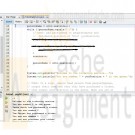
PRG/421 Week 4 Java 4.15 LAB: Ticketing service (Queue)
Regular Price: $7.00
Special Price $3.00
PRG/421 Week 4 Java 4.15 LAB: Ticketing service (Queue)
Given main, complete the program to add people to a queue. The program should read in a list of people's names including "You" (ending with -1), adding each person to the peopleInQueue queue. Then, remove each person from the queue until "You" is at the head of the queue. Include print statements as shown in the example below.
Ex. If the input is
Zadie Smith
Tom Sawyer
You
Louisa Alcott
-1the output is
Learn More
Welcome to the ticketing service...
You are number 3 in the queue.
Zadie Smith has purchased a ticket.
You are now number 2
Tom Sawyer has purchased a ticket.
You are now number 1
You can now purchase your ticket! -
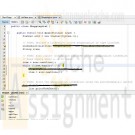
PRG/421 Week 4 Java 4.13 LAB: Grocery shopping list (LinkedList)
Regular Price: $7.00
Special Price $3.00
PRG/421 Week 4 Java 4.13 LAB: Grocery shopping list (LinkedList)
Given a ListItem class, complete the main() using the built-in LinkedList type to create a linked list called shoppingList. The program should read items from input (ending with -1), adding each item to shoppingList, and output each item in shoppingList using the printNodeData() method.
Ex. If the input is
milk
bread
eggs
waffles
cereal
-1the output is
Learn More
milk
bread
eggs
waffles
cereal





